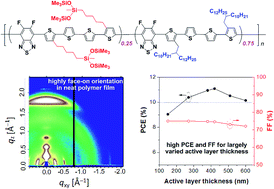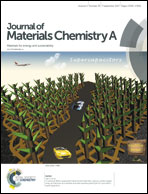Low band gap conjugated polymers combining siloxane-terminated side chains and alkyl side chains: side-chain engineering achieving a large active layer processing window for PCE > 10% in polymer solar cells†
Abstract
Alternating and random conjugated copolymers with a siloxane-terminated side chain for a repeating unit based on 5,6-difluoro[2,1,3]benzothiadiazole (FBT) and quarterthiophene (4T) were synthesized, among which side-chain random copolymers PFBT4T-C5Si-50% and PFBT4T-C5Si-25% with low contents of 50% and 25% siloxane-terminated side chains, respectively, in conjunction with alkyl side chains were found to be more suitable for optoelectronic applications due to good film-forming in solution processing. Grazing incidence X-ray diffraction (GIXD) indicated that the siloxane-terminated side chain could induce PFBT4T-C5Si-50% and PFBT4T-C5Si-25% with face-on orientations, giving high 3-D hole transport in neat films as supported by a high hole mobility up to 2.46 cm2 V−1 s−1 in field-effect transistors and an SCLC hole mobility up to 5.9 × 10−2 cm2 V−1 s−1 in hole-only devices. Fast SCLC hole and electron transports were seen for their bulk-heterojunction (BHJ) blend films with PC71BM as the acceptor, due to the retention of a polymer face-on orientation. The BHJ blend film of PFBT4T-C5Si-25% showed lower film surface roughness, more balanced hole and electron transport, and relatively smaller phase separation when compared with PFBT4T-C5Si-50%, as evidenced by atomic force microscopy (AFM), transmission electron microscopy (TEM), SCLC, and resonant soft X-ray scattering (RSoXS) measurements. The PFBT4T-C5Si-25%-based PSCs with 270, 420, and 600 nm thick active layers exhibited outstanding power conversion efficiencies (PCEs) of 10.39%, 11.09%, and 10.15%, respectively, readily offering a high thickness tolerance to achieve an unprecedented wide active layer processing window for PCE > 10%. This is also the first PCE of more than 10% achieved by an active layer of a 600 nm thickness level in PSCs. Another notable feature is very high fill factors of more than 74% and 71% being achieved for very thick active layers of 420 and 600 nm, respectively. The results suggest that side-chain engineering through the incorporation of a partial siloxane-terminated side chain is a unique handle to afford new photovoltaic polymers with enhanced vertical carrier transport towards application in roll-to-roll processing of PSCs.



 Please wait while we load your content...
Please wait while we load your content...